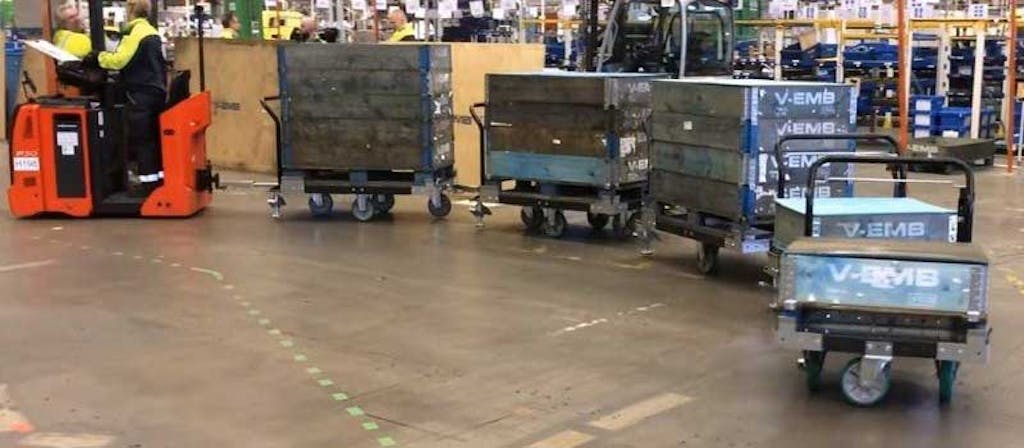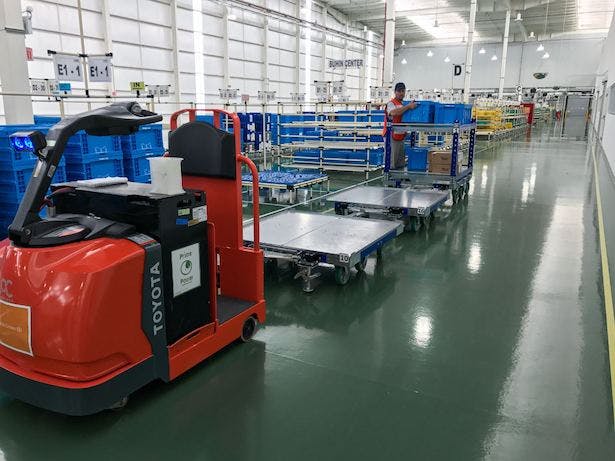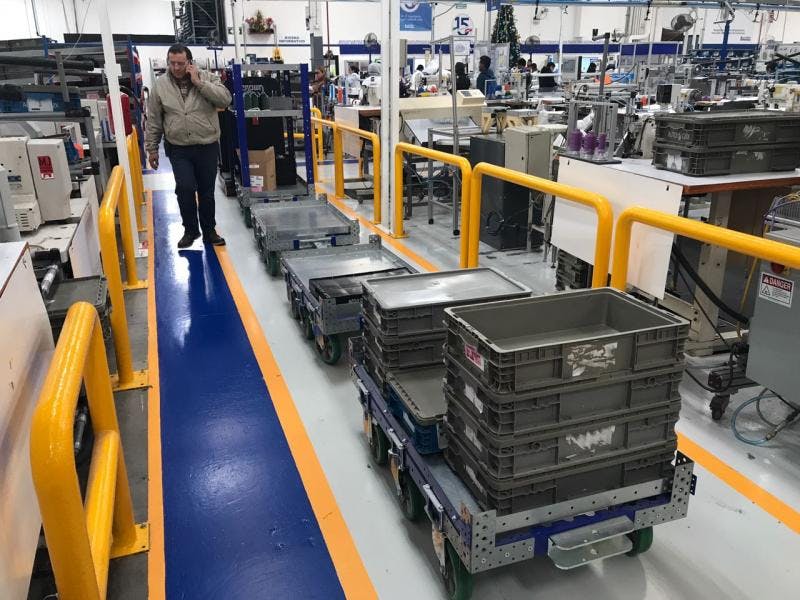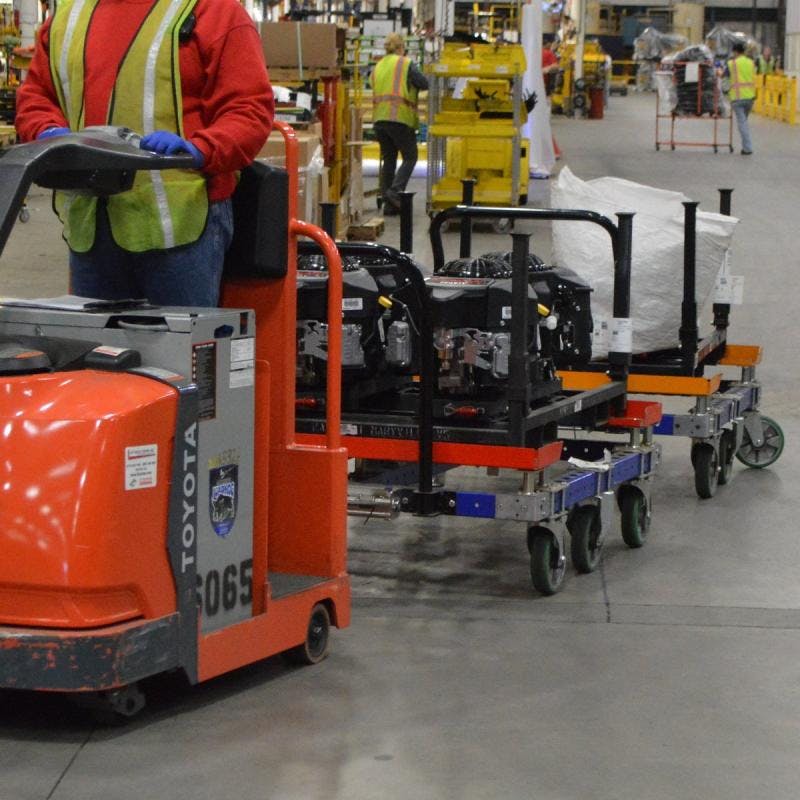From Forklifts to a Tugger Train System

Last Reviewed: 2024-04-09
The Forklift has been around for a long time and has been used for order picking, item relocation, and general product logistics.
It’s practically a staple in logistics operations. But a ‘new guy’ is toppling the old guy from being the king of the warehouse. It’s called the Tugger Train, and more and more companies are adopting this system.
What Is A Tugger Train System?
Tugger train systems have the same function as a real train, but on a smaller and more focused scale – to transport materials efficiently within a warehouse. A tugger train consists of warehouse tugger carts that get towed by a tugger operator, acting as a locomotive. The number of carts in a tugger train system varies depending on materials, quantity, demand, and space. Even different styles of warehouse tugger carts can be used in a tugger train, also depending on what’s mentioned above.

Using a warehouse tugger train has many advantages (which are listed below), and it’s a significant first step towards a forklift-free and safer environment.
Why Go Tugger Train?
There’s a developing trend towards reducing forklift usage and even ultimately going completely forklift-free. This is due to a lot of reasons, most notable of which are:
- In 2015 alone, around 100 people in the US were killed in accidents that involve forklifts. 35,000 out of approximately 100,000 forklift-related accidents have resulted in fatal injuries. The annual cost for these deaths and injuries amount to $ 135 million.
- Operational costs. The forklift is expensive equipment. Operational costs, which include maintenance, repairs, and fuel can curb a significant cost from a company’s budget. Not to mention the salary paid to forklift operators who undergo specialized training and certification before manning this hunk of metal.
- Ease of Use. Tugger trains are simplistic material handling equipment. They are generally easier to deploy and make use of for handling materials. They also make material transportation much easier when compared to the traditional forklift.
- A forklift can only move one load at a time so multiple runs have to be made when facilitating an order request. This is inefficient and not cost-effective.
- The carts used in a tugger train system can be customized for various applications. This makes it easier to carry a variety of loads.
Tugger trains, on the other hand, are getting more popular because of their advantages over forklifts. Some of these advantages include:
- Consumes less energy.
- Saves time. A tugger train can move more than one load at a time by linking multiple carts to a single tugger saving time.
- Saves money. Tugger trains are cheaper than forklifts. Tugger train operators require less pay than forklift operators.
- Reduces accidents and shop floor injuries.

Planning the Transition
Going from forklift to a train tugger system is not an overnight process. Planning alone can take months. The actual implementation may take months to complete and years to perfect, making adjustments as the processes become more mature with time. Here are factors that you need to consider when implementing a tugger train system to replace your forklifts.
Using Space Most Efficiently
If your warehouse space was designed for forklift operation, you might need to make adjustments in order to reduce bottlenecks and congestion on the floor. You’ll need to design routes, especially for tugs and carts, if you want to improve the materials’ transport flow. With enhanced flow come inventory reduction and productivity improvements for your workers. There is also less requirement to buffer, unlike when using forklifts.
Length of the Train
The length of the cart train that the tugger will pull depends on plant size, aisle widths, tug capacity, type and size of tugger carts, and plant safety regulations. Assembly plant deliveries typically require two to three carts. If sequenced using the last in, first out system, longer trains (around six to eight) is possible as long as there is sufficient capacity in the tug, the steering of the cart is modified properly, and there are large enough aisles to handle the train’s turns. You’ll usually see trains with six to eight carts in warehouses transporting materials to the dock and back. They are also common in put-away and sorting locations.
Cart Types and Configurations
There are different types of carts and configurations that can be used depending on your requirements. Choosing the correct ones will depend on the size, weight, and shape of your load and product, the configuration of the plant, and if a sequencing system is in use.
Not for Vertical Stacking
One advantage of the forklift over the tugger train system is the ability to pick and stack materials vertically. The tugger is not designed for this scenario. You should implement another type of handling equipment like reach trucks or order pickers to safely load and pick vertically.
Tuggers and Carts Beyond the Plant
The usual notion is that a tugger train system is good for plant use only. That is not the case. This system can also move products and materials between the warehouse and the plant. And since you will be moving more load in a single trip, transporting using tugs and carts are more cost-effective.
Effects on Operation Areas
When you replace forklifts with tugs and carts, you need to make modifications to operation areas in order to the new system. That is why it’s highly recommended that you include your plant workers when doing the planning because they are more familiar with the flow and the issues that are commonly encountered during transport.
Thus, plant workers must be trained on the proper way to apply tugger trains and carts. This enhances overall productivity levels through proper use. It is also worth noting that tugger trains require only one operator who drives the train. This ensures other factory workers are gainfully employed elsewhere.
Plan Early
Those who fail to plan are planning to fail, that’s a well-known cliché but it applies to transition from forklifts to tugs and carts. If you want to succeed with the transition, you need to plan early.
You should list all your goals and analyze the current scenario. You may also use simulations to test your assumptions and confirm which approach to take. Identifying improvement potentials should also be part of the planning process.
If the transition project is huge and involves factors that may hinder production and output, plan the transition in increments. A change in processes translates to work changes for the employees and changes in habits. Doing the transition in one go may be met with resistance. Accomplish small milestones instead of making the transition more palatable. It is also recommended that you seek help from more experienced material handling professionals to ensure the entire plan fits your facility’s environment.
Going Clean and Green
With all the discussions about environmental changes, emission reduction, and energy-efficient operations, transitioning to the tugger train system is the way to go. Tugs require less power to operate, which means less fuel and less emission. There are even tugs that run on rechargeable batteries.
Going from forklifts to tugger train systems need not be painful if you plan accordingly. The benefits are more than worth the cost and time spent during implementation. There are even companies that have decided to retain their forklifts. These operate within the perimeter area of the warehouse for loading to and from trucks while tugs and carts are operated inside the plant. That is power complementing efficiency.
Industry 4.0
If you intend to develop a smart factory, tugger trains can help. You can choose to integrate sensors such as weight and speed sensors to track important parameters. The data from these sensors can be used to ensure delivery times are more efficient.
Data Collected from tugger trains can also be used for predictive maintenance. You can determine if the tugger vehicle is working below par and service it before a breakdown occurs. This reduces downtime and eliminates replacement costs.
Want to know more? Contact us!
Are you interested in learning more about our tugger carts? Fill out the form and our experts will reach out to you!







